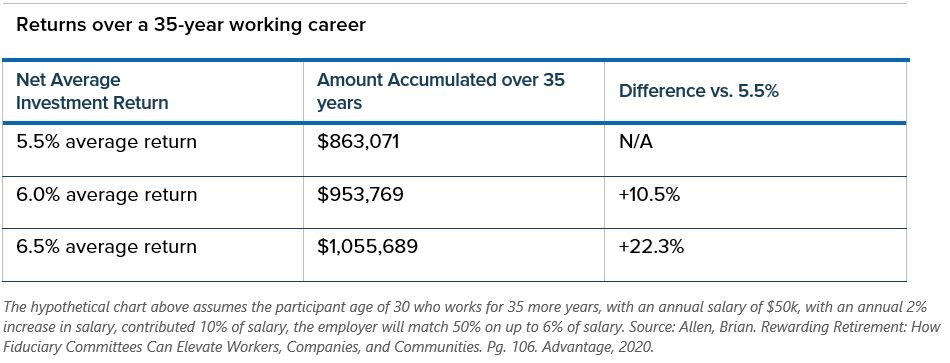Featured
Fiduciary Tools
Investments
Retirement Readiness
Investment Returns Matter: How Fiduciary Committee Decisions Impact Retirement Readiness
Last Updated: October 26, 2023

As a fiduciary committee of a company’s retirement plan, you have a lot of big responsibilities to your plan participants. From legal obligations to monitoring fees and service providers to providing ongoing education, there’s a large to-do list. Not only is the to-do list vast, but all decisions you and your fellow members make can have a significant impact on the retirement readiness, and overall financial security, of your workforce.
One of the most vital responsibilities incumbent on the committee is selecting and monitoring the investment options available in your plan. Along with appropriate plan fees and participant total contributions, investment performance is one of 3 key drivers that impact retirement readiness.
Fiduciary committees influence participant investment performance through the adoption of investment lineups. A critical component of a good 401(k) plan is an investment lineup that performs well. Returns that are made on an investment can compound powerfully over time. Since helping your participants save up enough money to get on track for retirement is the ultimate goal of your plan, it’s important you understand your investment lineup’s performance.
3 ½ Top Yet Uncommon Tips
to Level Up Your 401(k) Investment Lineup
As a fiduciary, you’ve got a lot on your plate. We understand the weight of those responsibilities. That’s why we put together PCI’s 3 ½ top, yet uncommon, tips to level up your plan’s investment lineup.
Small Differences Matter
Small improvements in your investment lineup’s performance, compounded over a working career, can dramatically improve the retirement readiness of your employees.
Even a one percent increase in returns, when compounded over time, can equal years in retirement savings. To illustrate this point, let’s look at this hypothetical example that displays the impact a 5.5% return vs. a 6.5% return can have on a participant’s 35-year career.
Meet Kelly. Kelly is a participant in your plan. She is thirty years old with an annual salary of $50,000 and a 2% increase in salary per year. She contributes 10% of her salary, and her employer matches 50% of up to 6% of her salary.
Kelly will work for your company for another thirty-five years, retiring at age sixty-five. With a 5.5% average return, she’ll be looking at $863,071 upon retirement. While that number is nothing to scoff at, let’s look at the difference a 1% increase will make for her.
A 6.5% average return will fetch her $1,055,689 in retirement. By increasing her returns by just 1%, she’ll grow her retirement by $192,618. This represents a significant 22.3% difference when compared to an average return of 5.5%.
The Problem
Despite the weight of investment decisions that are ultimately the fiduciary’s responsibility, likely, your committee isn’t comprised of stock traders or trained investment professionals. Many opt to hire service providers, such as plan advisers, to help them navigate these critical decisions. Plan advisers select the funds to include in the lineup (often called manager selection) and monitor those funds.
The problem here is that, oftentimes, committees will put too much faith in their plan adviser’s manager selection, assuming that they know best. Why wouldn’t they? They are the professionals, after all.
Unfortunately, a blind over-reliance can backfire. It’s important to remember that advisers are human, and some are better than others. As Ronald Regan famously said of the Soviet Union, “Trust, but verify.”
Too frequently, we find committees lack a clear understanding of their lineup’s actual performance.
They only know what their plan adviser has shared with them. The sad truth is that it isn’t always in the adviser’s interest to reveal their performance records when it comes to manager selection. Due to this unfortunate lack of transparency, many fiduciary committees do not have a clear idea of what is happening with their plan or if it is providing meaningful value to participants.
Unfortunately, research indicates that most retirement plan investment lineups do not perform as well as they should.
Every year, Dr. Rui Yao, PhD, CFP®, of the University of Missouri engages in an annual independent study conducted to determine whether the investment portfolio of mutual funds – the investment lineup – inside defined contribution plans have outperformed comparable groups of market indices.
The initial results and analyses were peer-reviewed and then published in 2020 as “Use of Advisors and Retirement Plan Performance” in the distinguished academic publication Journal of Financial Counseling and Planning (31(1)). Cody Mendenhall, CFP®, currently a Principal of Pension Consultants, Inc., was a co-author, along with Weipeng Wu, MA.
The study found that over the last 8 years, when aggregated among all plans of all sizes, only 37% of Defined Contributions plans were outperforming their appropriate and respective benchmarks.
The likely reason that fiduciary committees have tolerated poor fund performance is because it was never reported to them.
Here’s How To Do Better
Fiduciary, you hire and entrust your plan adviser to provide meaningful outcomes for your plan participants. You deserve to know without a doubt how your plan is doing and have confidence it’s helping them get, and stay, on track for retirement.
Choosing the right adviser that will help you provide an investment lineup that contributes to your employees’ retirement readiness can make a difference.
Here’s how you can gain that confidence:
-Establishing objective performance standards (benchmarks) for your investment lineup’s performance.
-Receiving clear, transparent reporting that expresses the performance in relation to the performance standard.
-Ensuring each fund is in the lowest cost share class. Every dollar saved in fees is a dollar in participants’ pockets.
Never forget your responsibility to your participants. Maintaining an investment lineup that performs well is a fundamental job every fiduciary is entrusted with. Providing them with a diverse and well-structured investment lineup is not just a duty but a pathway to empowering them to build a sturdy bedrock for their retirement.
If you would like to learn more about how you can provide an investment lineup that helps your employees retire on time, don’t hesitate to schedule a consultation with our team of experts.
Reserve your spot for our upcoming workshop.
- Pension Consultants, Inc. is registered with the U.S. Securities and Exchange Commission as an investment adviser, located at 300 S. Campbell Ave., Springfield MO, 65806. For questions or more information contact us at 417.889.4918.





